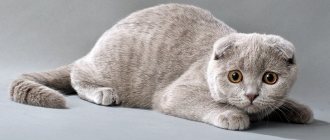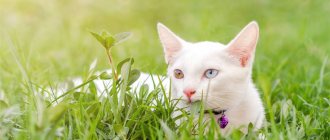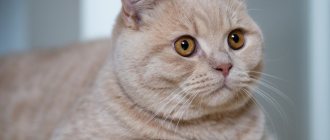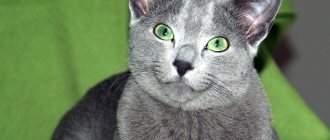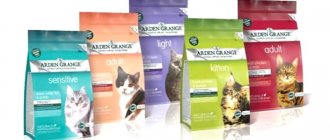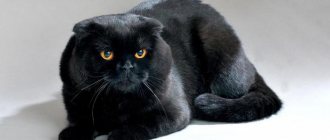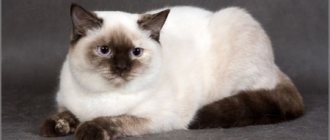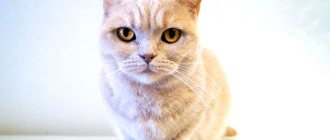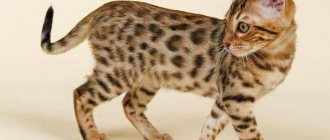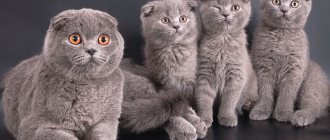Domestic felines with curved ear tips to match the shape of their heads, large expressive eyes, dense builds and plush fur are very popular. This is a British Fold cat. The contradiction can be read already in the very name of the breed. Representatives of the “British” have exclusively erect ears, while the “Scottish” may have floppy ears. It turns out that the breed does not exist. From an official point of view, this is true. But these sweet noble creatures have not left anyone indifferent for more than a decade.
Is there a breed of British Fold?
If you try to find this breed in the list of FIFe or other international felinological organizations, you will fail. Officially, the “British Fold” breed does not exist (British breeds are divided into short-haired and long-haired, both of which have beautiful erect ears). What kind of cats are called “British Fold”?
The history of the origin of the fold cat breed
Cats with folded ears were first officially registered in 1961. The cat Susie became the ancestor of a new breed, which was later called the Scottish Fold. Cute plush cats with large bright eyes and a very balanced character quickly gained popularity and in 1976 were officially recognized as an independent breed. During the period of breeding work, an unpleasant fact was revealed: when crossing two lop-eared parents, the offspring have a number of genetic diseases and are not viable. Therefore, crossbreeding was carried out with other short-haired breeds: exotics, British and Americans. In this case, the litter could contain both fold-eared kittens (Scottish Fold) and babies with erect ears; they were called Scottish Straight (this variety later also received the status of an independent breed).
Currently, mixing Scottish cats with British Shorthairs is prohibited, as this contributes to the development of genetic diseases. The British Fold cat breed does not officially exist. Scottish Folds are offered under this name, but since the ancestors of this breed were also British, there is some basis for using such a name. Such pets touch with their appearance and captivate with their sweet character, so they enjoy well-deserved popularity.
Photo gallery: British and Scottish cats
Blue British Shorthair
Longhaired British (Highland) golden chinchilla color
Long-haired Scottish cat with straight ears (Highland Straight) tabby color
Long-haired Scottish fold cat (Highland fold) bicolor color
Shorthair Scottish cat with erect ears (straight) red tabby color
Shorthair Scottish Fold cat (fold) gray point color
Colors
The luxurious plush coat of the British Fold is always stuffed and soft to the touch, and thanks to the cleanliness of this breed, it is always shiny and looks well-groomed. At the same time, kitties have a neat and gentle appearance, while cats can be slightly disheveled.
Colors can take on a wide variety of shades and patterns, including:
- Single color solid. Gray-blue representatives are more common, although some have fur that can be red, black, grey, brown, lilac, and less commonly white or peach.
Solid white
- Striped, marbled or spotted colors are indicated by adding the word "tabby" to the base color. At the same time, on a lighter base there are dark stripes, stains or spots that form the letter “M” on the forehead.
Tabby
- A smoky shade appears when each hair is colored only a third of the main color, and a chinchilla shade - if it is an eighth. The rest of the fibers may be silver or white. Also read the article about the British chinchilla.
Chinchilla shade
- The Siamese Colored has a light body with darker limbs. Thus, chocolate or almost black paws, tail, ears and muzzle stand out against a cream background.
Siamese Colored
- Tortoiseshell coloration is often black with splashes of different shades of red. Sometimes cream can be combined with gray or brown.
Tortoiseshell coloring
- Bicolor has two colors - white with blue, chocolate, black. Light in the lower part of the body, combined with tortoiseshell at the top, forms the “calico” color, characteristic of Scottish cats.
Color Bicolor
Description of the appearance and character of British and Scottish cats
Although these breeds are often confused, their appearance differs significantly.
The British and Scots are different
Table: differences between British and Scottish cats
| Comparative criterion | British cat | Scottish cat |
| Body type | Large, massive, rectangular in shape, weighing from five to eight kilograms. | Not massive, the body shape is more rounded, weight from three to eight kilograms. |
| Paws | Shorter legs with rounded paws. | Long, graceful. |
| Tail | Short and fluffy. | Longer. |
| Head shape | Rounded, whisker pads well defined, small chin, but the British are distinguished by large, plump cheeks. | |
| Nose | Straight, wide, with a small depression, smoothly turning into a wide forehead. | |
| Eyes | Bright, large, widely set, the color of the iris can vary, but the most common is deep amber. | |
| Ears | Standing only, wide apart. | They can be upright or down with a forward bend. |
| Wool | It can be both short and long. British shorthairs are famous for their velor coat, which is very pleasant to the touch. | |
| Color | For the British, light blue is considered classic. But now both breeds can have a wide variety of coat colors (there are almost two hundred colors), including: black, lilac, chocolate, cream, white, bicolor, tabby, and tortoiseshell. | |
British and Scottish cats differ in the shape of the head, the location of the ears on it, and the general structure of the body.
Video: why the Scots and the British are different breeds
Characteristics of British and Scottish cats
The British cat breed is distinguished by its independence, intelligence and truly royal calm; they are very devoted to their owner and can even show signs of jealousy, but are not intrusive; They can be reserved, almost indifferent, or they can play with pleasure with children, provided they are treated with respect. When hungry, this pet will not scream loudly or caress annoyingly, demanding food. He can sit near the bowl and look indignantly at the owner, reminding him of his responsibilities. The British can be very persistent and stubborn in their demands, so you must immediately learn to find a common language with this pet.
The Scottish cat is often recommended for families with small children; they are absolutely devoid of aggressiveness and are very affectionate. Scottish cats are friendly not only with people, but also with other pets; They calmly tolerate new society, but do not like to be alone.
Both breeds are distinguished by cleanliness and intelligence; there will be no problems with training them to use a litter tray and keep the house in order.
Although these cats are not hypoallergenic, there is evidence that even allergy sufferers tolerate their presence in the apartment well. In any case, before purchasing a kitten from a nursery, it is better to test for allergies of this particular animal.
Video: what breed of cats are fold-eared?
There are differences in the behavior of British cats and Scottish ones. These differences are related to the structure of the body:
- British women do not stand on their hind legs;
- not sitting;
- are not afraid of heights.
Relationships with other household members
Representatives of this breed adapt well to new conditions. They do well in large families with children or other animals. They are extremely loyal to children and forgive them many pranks. Scottish Fold cats are not inclined to show aggression towards people.
If a pet has more Scottish admixture, its character will be more active and cunning. An inherent feature of such individuals is spontaneous activity. A cat can sit quietly and suddenly suddenly attack a moving object in the apartment. Also, lop-eared dogs will not suck up to the owner or purr at him. This is dictated by self-esteem.
Purchasing a fold kitten
Despite the absence of the British Fold breed, advertisements for the sale of kittens can be found quite often. This fact once again demonstrates the undesirability of purchasing a kitten through advertisements or on the poultry market. And yet, if you decide to get a kitten of the British or Scottish breed, it is better to buy it from a breeder or nursery. Experienced specialists better select a pair for mating so that the future offspring are healthy and have an attractive appearance.
A kitten is purchased at no younger than 10–12 weeks of age. By this time, he will have already received primary vaccinations, he will eat and use the litter box on his own. Newborns' ears droop on the twenty-first day, so it is not difficult to distinguish a fold-eared kitten. The British have shorter legs and have club feet when walking.
The cost of a fold-eared kitten when purchased through an advertisement will not exceed five thousand rubles. If you purchase a kitten from an officially registered breeder, you will receive the entire set of documents (the baby’s passport indicating the pedigree and date of birth, a sales contract and a vaccination certificate) and the purchase price will be several times more expensive. The cost is influenced by the appearance of the future pet and the opportunity to participate in breeding and exhibitions.
Keeping a cat
The maintenance of British and Scottish cats does not have any significant differences, and both are not picky about their care. Their content includes a set of hygiene procedures typical for all pets:
- Eye care: it is necessary to remove small dark deposits from the corners of the eyes with a napkin as they appear.
- Ear care: both erect and drooping ears need to be cleaned; earwax and dirt can accumulate on their insides; Once every two months it is necessary to inspect the ears and, if they are dirty, clean them with cotton pads soaked in hydrogen peroxide or a special liquid for cleaning the ears of animals. This operation must be performed carefully, without going deep into the ear canal. If ear dirt appears frequently, this is a sign of disease or the appearance of ear mites. In this case, you need to contact a veterinarian.
- Pets need dental care just like people. To clean teeth, use special toothbrushes, toothpaste with the taste of cat treats, or at least adding solid food to the diet, which the cat will chew on to clean its teeth. Once every six months, it is advisable to visit a veterinarian or dentist.
- To care for claws, there should be a scratching post in the house, but if this is not enough, you need to periodically trim the claws with a special nail clipper. It is not advisable to use scissors, as they can damage the skin of your cat's fingers.
- Hair care consists of periodic combing. For a short-haired breed, once a week is enough, but it is better to brush the cat one more time than to collect hair all over the apartment. Brushing is usually a pleasure for pets; they perceive it as a massage, and the British like it, and combing against the grain, which is not usually typical for cats. Long-haired cats need to be brushed daily to keep them looking well-groomed and not leaving clumps of fur. In addition, once every six months the cat needs to be washed in warm water (at a temperature of forty degrees) with special shampoos. Bath towels are used for drying, although some pets are comfortable with drying with a hairdryer.
- A litter tray is used for the cat's toilet; It is better to consult with the breeder which filler to initially purchase. These cats are particularly clean and can be capricious when choosing litter.
When purchasing a pet, you should not forget about dishes for food and water and a carrier for visiting the veterinarian. If you purchase a special corner for your cat, she will be happy to live there.
The British and Scots are very fond of large spaces; if you have a private house with a garden plot, this is the best option for their residence
How and what to feed your pets
Scottish and British cats are not picky eaters. Due to their massive size, British cats must receive thirty percent more food than ordinary cats. However, you need to remember that this breed is prone to obesity. And given skeletal problems and a tendency to heart disease, excess weight can have a negative impact on your pet’s health. Scottish cats are not prone to obesity, but their diet should not contain fatty foods. In order for your pet to be healthy and live a long time, you need to pay great attention to the correct preparation of a balanced diet.
The easiest way to solve this problem is to choose premium ready-made food. These feeds are already balanced, contain vitamin and mineral complexes and offer a choice of feeds for special purposes: for hair removal, for urolithiasis, for castrated animals. The serving size based on the weight of the animal is indicated on the product packaging. The disadvantage of such a diet is its high cost.
When organizing feeding with natural products, you need to take into account that about seventy percent of the diet should be protein foods. The diet can include:
- all types of meat and offal, with the exception of pork and lamb; the meat is given boiled or raw, but scalded with boiling water, and cut into small pieces so that the cat does not choke;
- porridge - it is recommended to cook oatmeal or rice; they can be seasoned with vegetable oil;
- vegetables are given boiled in small quantities; due to the starch content, it is not recommended to feed cats potatoes;
- sea fish of any kind, but not more than once a week due to the possibility of urolithiasis;
- low-fat dairy products: yogurt,
- cottage cheese,
- sour cream,
- fermented baked milk (milk is not always suitable for adult cats).
When using natural food, be sure to add vitamins and minerals, especially during the growth period.
Whatever type of feeding you choose, your pet should always be provided with clean (preferably filtered) water.
Recommended food
1. The diet must be balanced and contain the necessary vitamins, macro- and microelements. Give preference to food from trusted manufacturers. You can choose dry
or
wet
food, and also combine them in equal proportions.
2. Spayed and neutered animals are prone to gaining excess weight and developing urolithiasis. Specialized food
is suitable for them .
3. It is better to feed kittens with wet food, switching to dry food is carried out from 3 months. 4. Don't forget to change the water in the bowl
.
If it is not possible to monitor the amount of liquid, an automatic drinker
.
5. Periodically pamper your pet with treats
.
6. To prevent vitamin deficiency, the usual diet can be supplemented with dietary supplements
containing the necessary vitamins and minerals. It is best to consult your veterinarian before use.
Health status of British and Scottish cats
Both Scottish and British cats have good immunity and rarely get sick, but they are prone to hereditary diseases. These diseases are associated with the structural features of the body and each breed has its own.
Due to their powerful and heavy build, British cats often suffer from diseases associated with improper skeletal development. This can be expressed as deformation of the spine, carpal and metatarsal bones. There are sets of physical exercises for cats suffering from spinal diseases. But you need to consult a veterinarian about the system for carrying them out.
Bone growths may occur on the fingers. In this case, the cat begins to limp, and only surgical intervention can help him.
Defects in skeletal formation sometimes lead to cardiomyopathy. This disease manifests itself in an adult animal, so it is advisable to do an ultrasound of the heart annually for prevention and timely treatment.
For the Scottish breed, joint diseases are more vulnerable, leading to decreased mobility (this disease is especially common in the joints of the tail). They are also predisposed to kidney and gastrointestinal diseases. The Scots inherited a tendency towards cardiomyopathy from their British ancestors.
In addition to taking into account these hereditary characteristics, to maintain the health of your pet, it is necessary to monitor the absence of external and internal parasites and carry out revaccination vaccinations on time.
Video: health problems of fold-eared cats
With good care and timely treatment, your pet will live at least twelve years, and quite possibly more. One of the important factors affecting the health of cats and kittens is their timely sterilization or castration. (Now veterinary clinics offer a number of similar operations, each of which has its own pros and cons) and if you are not going to breed the breed, then it is advisable to do this operation in time. The operation has no age restrictions, but a young animal tolerates surgery more easily, and hormonal changes will be less noticeable.
Video: to castrate an animal or not
Kinds
There are 4 types of Scottish cats, two of which are fold-eared. These are the Scottish Fold and Highland Fold subspecies.
A subspecies of the Scottish Fold breed is a short-haired, fold-eared Scottish cat. Its distinctive feature is ears that wrap around the head, large eyes, a round muzzle and head. Most people prefer this type of lop-eared cat because it produces less fur throughout the house.
The character of the Scottish Fold is another parameter for which this breed is adored by millions of cat lovers around the world. The fold-eared cat is absolutely not aggressive, soft and affectionate. She gets along easily with both humans and pets.
Unfortunately, the lop ear gene leads to many diseases, especially joint diseases. The future owner of the cat must be aware of this feature and properly care for the pet.
The Highland Fold is the second variety of the Scottish Fold cat, only with long hair. Some representatives of the breed can be so fluffy that they look like a big furry ball without ears.
The Highland Fold's character is the same as its short-haired counterpart - calm, non-conflicting and compliant.
Features of breeding fold cats
If you want to try your hand at breeding purebred cats, then it’s better to start by studying in felinological courses, which teach the basics of genetics, veterinary medicine, and tell you about the rules for holding exhibitions and about international felinological organizations. Before organizing the mating of your pet, it is necessary that he take part in the exhibition. Even if the cat did not take a prize, it received a rating for its class, this could be:
- Pet class is an animal with a slight defect that cannot be used in breeding work.
- Breed class - full compliance with the breed standard and in good health for procreation.
- Show-class - not only compliance with the standard, but also a bright appearance, which allows you to receive prizes at exhibitions.
Only after receiving the class can your pet officially take part in the breeding work of the felinological club.
The difficulty in breeding fold cats lies in the correct selection of partners. Under no circumstances should fold-eared cats be mated with fold-eared cats. In such a mating, all offspring will have genetic diseases. In addition, the color of the animals is taken into account to obtain the best result.
It is advisable to breed young animals with more experienced partners at the age of about one and a half years (a cat during the third heat). To find a suitable partner, a felinological club is used and the act of mating is documented so that the kittens born have a correctly issued passport.
Table: advantages and disadvantages of British and Scottish cats
| Advantages. | Flaws. |
|
|
Buying a kitten
If you decide to buy a British Fold, take a closer look at the animal from the shelter. It is worth remembering that such a pet is not suitable for exhibitions or breeding, but it is quite suitable as a beloved pet. When buying a kitten from your own hands, you should be careful not to buy an animal with a bunch of hereditary diseases.
How much does a British Fold cat cost?
Since British Folds are not considered thoroughbreds, they have a lower price than their purebred relatives. A beautiful cat can be found for a nominal price. The cost of a pet without documents can range from 2-6 thousand rubles and more. You can buy it online, in underground passages, or at the market. Some owners simply give them to good, kind hands.
No matter what breed your cat is, it is, first of all, an animal, and it needs affection and love. In return for the warmth, the owner will receive a lot of positive emotions.
